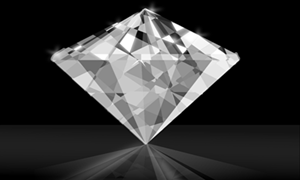Diamond Clarity
Since they are formed deep within the earth and under extreme heat and pressure, all diamonds contain flaws. Diamond clarity, one of the four Cs of diamond grading, refers to the degree to which these flaws or imperfections – either inside the diamond (called inclusions) or on its surface (called blemishes) – are present. Inclusions can be crystals inside the stone, or tiny cracks that make the diamond appear cloudy or “whitish”.

Grading Clarity
Almost all diamonds are graded based on the 11 point diamond clarity scale created by the GIA. The number of flaws in the diamond, as well as their size, relative location, orientation and visibility affect the clarity of the diamond and therefore – the stone’s grading. According to the GIA, the grading for clarity is done under 10x magnification.
The GIA diamond clarity scale runs from Flawless (the rarest kind) to Included (in which inclusions are defined as “obvious” under magnification). The scale has six categories, divided for a total of 11 specific grades. They are as follows:
- Flawless (FL): diamonds have no inclusions or blemishes visible under 10x magnification. This is extremely rare, as less than 1 in 5,000 jewelry quality diamonds are rated FL.
- Internally Flawless (IF): diamonds have no inclusions visible under 10x magnification, and only small blemishes on the diamond surface.
- Very, Very Slightly Included (VVS1 and VVS2): Inclusions are so slight they are difficult for a skilled grader to see under 10x magnification.
- Very Slightly Included (VS1 and VS2): Inclusions are observed with effort under 10x magnification, but can be characterized as minor
- Slightly Included (SI1 and SI2): Inclusions are noticeable under 10x magnification.
- Included (I1, I2, and I3): Inclusions are obvious under 10x magnification and may affect transparency and brilliance.
.
Diamonds with higher clarity grades naturally cost more, with the exceedingly rare Flawless graded diamond fetching the highest price.

